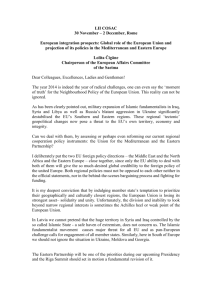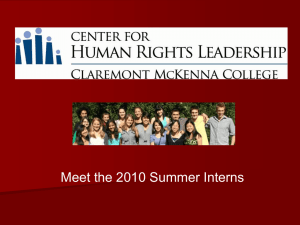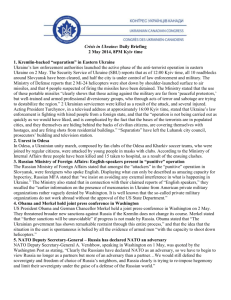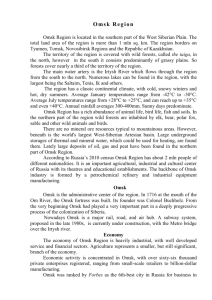Missionary Teaching Trip Latvia, Estonia, Russia, Ukraine June 30
advertisement
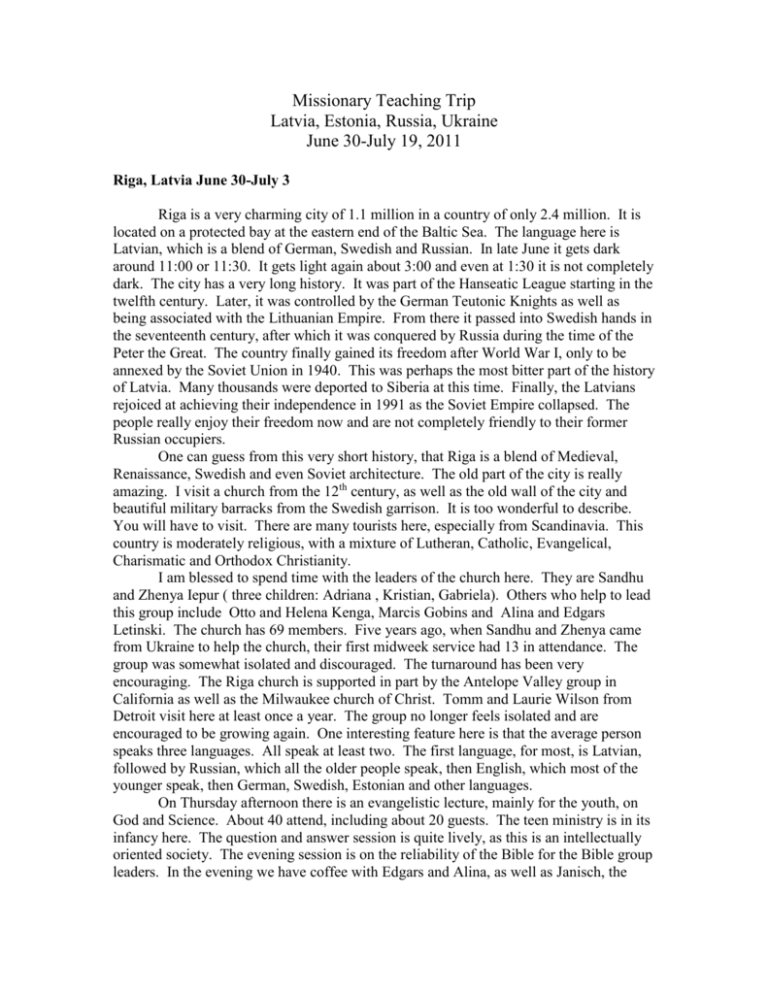
Missionary Teaching Trip Latvia, Estonia, Russia, Ukraine June 30-July 19, 2011 Riga, Latvia June 30-July 3 Riga is a very charming city of 1.1 million in a country of only 2.4 million. It is located on a protected bay at the eastern end of the Baltic Sea. The language here is Latvian, which is a blend of German, Swedish and Russian. In late June it gets dark around 11:00 or 11:30. It gets light again about 3:00 and even at 1:30 it is not completely dark. The city has a very long history. It was part of the Hanseatic League starting in the twelfth century. Later, it was controlled by the German Teutonic Knights as well as being associated with the Lithuanian Empire. From there it passed into Swedish hands in the seventeenth century, after which it was conquered by Russia during the time of the Peter the Great. The country finally gained its freedom after World War I, only to be annexed by the Soviet Union in 1940. This was perhaps the most bitter part of the history of Latvia. Many thousands were deported to Siberia at this time. Finally, the Latvians rejoiced at achieving their independence in 1991 as the Soviet Empire collapsed. The people really enjoy their freedom now and are not completely friendly to their former Russian occupiers. One can guess from this very short history, that Riga is a blend of Medieval, Renaissance, Swedish and even Soviet architecture. The old part of the city is really amazing. I visit a church from the 12th century, as well as the old wall of the city and beautiful military barracks from the Swedish garrison. It is too wonderful to describe. You will have to visit. There are many tourists here, especially from Scandinavia. This country is moderately religious, with a mixture of Lutheran, Catholic, Evangelical, Charismatic and Orthodox Christianity. I am blessed to spend time with the leaders of the church here. They are Sandhu and Zhenya Iepur ( three children: Adriana , Kristian, Gabriela). Others who help to lead this group include Otto and Helena Kenga, Marcis Gobins and Alina and Edgars Letinski. The church has 69 members. Five years ago, when Sandhu and Zhenya came from Ukraine to help the church, their first midweek service had 13 in attendance. The group was somewhat isolated and discouraged. The turnaround has been very encouraging. The Riga church is supported in part by the Antelope Valley group in California as well as the Milwaukee church of Christ. Tomm and Laurie Wilson from Detroit visit here at least once a year. The group no longer feels isolated and are encouraged to be growing again. One interesting feature here is that the average person speaks three languages. All speak at least two. The first language, for most, is Latvian, followed by Russian, which all the older people speak, then English, which most of the younger speak, then German, Swedish, Estonian and other languages. On Thursday afternoon there is an evangelistic lecture, mainly for the youth, on God and Science. About 40 attend, including about 20 guests. The teen ministry is in its infancy here. The question and answer session is quite lively, as this is an intellectually oriented society. The evening session is on the reliability of the Bible for the Bible group leaders. In the evening we have coffee with Edgars and Alina, as well as Janisch, the leader of the church in Vilnius Lithuania (23 members). Edgars is very committed to beginning a campus ministry here in Riga. Friday included a visit to a wonderful little city about 50 km from Riga, with a little ski hill and several castles. Also there were classes on messianic prophecies and on the resurrection, followed by a class on Acts and Church History in the evening. Translation is into Russian, Latvian and Estonian. There were about 50 in attendance. Overall, there were about 25 guests Friday and Saturday. After this, we have a delightful picnic on the Baltic Sea, watching the sun set at 11:00 at night. Sunday was a lesson about Jesus in the Old Testament. There are 60+ in attendance, with a number of guests. The lesson is translated into Russian, Latvian and Estonian. This is a very multilingual church. One thought as I leave Riga is their need for an older couple to come and live here or at least to stay for an extended period of time. The church is mostly very young couples who could really use an experienced couple to shepherd the church. By the way, one definitely can live here speaking only English, as about 30% of the church speaks English, which is similar to the country as a whole. Tallinn, Estonia July 3-4 From Riga, I travel to Tallinn, Estonia. I am met by Alexander and Marco at the border to Estonia. Because both Estonia and Latvia are part of the EU, there is no border check at all. The drive to Tallinn is about four hours through pine forests and more farm fields as we enter Estonia. Estonia is really beautiful, although it is very flat. The country is only about 1.2 million people, with about 500,000 in Tallinn. The culture here is similar to Latvia, but the language is very different. It is similar to Finnish. Tallinn was settled in the 12th century by the Danish. It maintains more of a Scandinavian rather than a German feel. Estonia is a bit more prosperous than Latvia. Like Latvia, Estonia has suffered occupation by outsiders most of its history. This began with the Danes in the 12th century, followed by the Swedes and the Russians, with a brief independence after 1920, occupation by Russia in 1940, Germany in 1941, and Russia again from 19441990. This is a bitter history but the Estonians are very independent in their mindset and their culture is strong. I am staying at the home of Kaido Ledesma and his wife, who lead the church of 120 here in Tallinn. There are almost 100 children in the church as well, which gives a good idea of the makeup of this fellowship. There is also a smaller church in Tartu, in southeast Estonia (membership 13). Marco and his wife also work for the church. Strong, stable leadership has been a great help and the church has grown quite a bit lately. Estonia is much less religious than Latvia. Most members of the church I talk to came from atheist background. On July 4th is a tour of Old Tallinn. This is one of the most wonderfully preserved Late Medieval towns anywhere. The city began as a Danish port which was conquered by the Livonians. Perhaps the most building was under the Swedes. The wall is quite high. The narrow alleys, the varied architecture, including Gothic, Romanesque, Baroque, Classical as well as interesting local homes with very steep roofs make this a wonderfully charming old city. The view from the high city wall is spectacular. The church service was a lesson on Acts and Church History. There were 100+ in attendance, including 10+ visitors, which is actually pretty good considering this is a special meeting, scheduled on fairly short notice. The translation was into Estonian, with a small number needing Russian translation. The church here is very well educated, made of mostly professionals. They have a great hunger for deeper knowledge of God. Like Riga, one of the biggest needs is for a mature couple to come to provide local support to the growing family ministry. July 5-6 St. Petersburg, Russia The bus ride to St. Petersburg is seven hours, with a somewhat nerve-wracking crossing of the border at Narva, as all the instructions are in Russian. The drive is through pine, birch and aspen forest, interspersed with what appears to be povertystricken farms. All is quite flat here. I am met at the station in St. Petersburg by Sasha Samonin and his wife Natalia Samonine. They lead the South Region. I am staying at their house. I have lunch with them, Sasha Solovjov, my interpreter, Genja Sukhomlinov, the church administrator and Kshusha Baldina (campus ministry). We have the traditional borscht, a cold beat soup which is very good. This is the farthest north I have ever been. At midnight it is still quite bright outside. In fact, even at 1:30 it is still light out. I believe it never actually gets completely dark here at this time of year. St. Petersburg is a city of 5 million. The people here are more affectionate than the Latvians and Estonians. The people in the Baltics tend to give one another a lot of space, but here people touch more and are warmer. Personal space is near zero. St Petersburg has perhaps more beautiful monuments than any city in the world. Every building in the center seems like a palace. Most were built in the 1700s or 1800s, as this city was founded by Peter the Great in the late 1600s and built largely by him. Today we visited the spectacular cathedral of the holy blood, which commemorates the assassination of czar Alexander in the mid-nineteenth century. It is completely covered inside the cathedral with the most impressive mosaics of scenes from the Bible, especially the life of Jesus, prophets and church “saints.” The outside looks much like the more famous cathedral of St. Basil in Red Square, Moscow. It is an architectural wonder. I am also blessed to tour the Hermitage. This is a fantastic museum, including DaVinci paintings and “The Prodigal Son” by Rembrandt. This is perhaps my favorite painting. It is worth coming here just for this museum. But of course, the best part of the visit is meeting with the Christians. The church here is about 475 members. The church staff is twelve, but most are out of the city right now on holiday. There are nearly 50 churches in our fellowship in the former Soviet Union—about 10 in Ukraine and Moldova, 25 in Russia and 15 in the other republics. The church in St. Petersburg went through some hard times, but last year, for the first time in many years, it grew in numbers, which is very encouraging. The class I teach for the church is on having deeper and more fulfilling Bible study. There are about 300 in attendance. The fellowship is really great. After this, I am whisked off for an overnight train, leaving at 12:00 for Moscow. July 7-8 Moscow The overnight train, with four sleeping in a tiny room, is not the typical experience for an American. I am met by Sergei Glushonkov (wife, Marina daughter Eva), who leads the East Region. He has returned from family holidays just to spend time and to be my host. Thank-you Sergei! Moscow is a city of perhaps 18 million. It is the place where everyone in Russia wants to come because this is where the money is. This is a difficult country because the corruption affects every part of the life of the common people. Yet, there is a strong commitment to education, to the arts and to culture. The dominant religion here, of course, is Orthodox Christianity. The church is closely tied to the state here, so other Christian groups are at a disadvantage. I am fortunate to visit Red Square to see Basil’s Cathedral and the Kremlin, as well as Tretjakovskaya Gallery. Travel on the metro is extremely efficient. Trains carrying in excess of 1000 passengers come every two to three minutes. It is amazing to see the people move in and out. Street traffic is quite the opposite in its efficiency, as what should be a twenty minute drive can often take three hours. The church in Moscow just celebrated its 20th anniversary two weeks ago. There are approximately 1500 members here, in six regions. I am speaking for a special meeting, outside the normal schedule. Still, 200+ come to hear a lesson on The Kingdom of God on Thursday PM. A similar number come for a class on the book of Hebrews on Friday. The questions are really great and the fellowship is lively. There is a lot of interest in more profound study of the scriptures. A number of groups meet throughout the city to pursue deeper biblical studies. My friend Sergei is completing a theological degree. It is interesting that because many Christian groups here had to function independently, some false teachings such as Calvinism have become rare in Russia. This is an encouragement. Ekaterinburg, Russia July 9-10 The 1200 mile flight east to Ekaterinburg (pronounced Yekaterinburg) began at 2:00 in the morning, so sleep is optional this day. Ekaterinburg is the fourth largest city of Russia, with about 1.5 million inhabitants. There is a lot of heavy industry here, especially for the military. Many of the houses are made of logs and there is plenty of lumber industry locally as well. The outskirts have a rustic feel, but Ekaterinburg is a modern city. It is on the east side of the Urals, at the southern end, and is the capital of the Ural region. One famous (or perhaps infamous) thing about Ekaterinburg is that this is the place where the royal family, including Anastasia and her father Czar Nicolas II, were murdered by the Communists. The church in Ekaterinberg has a bit under 200 members It is led by Igor and Ira Petrov. Other leaders include Dima (Dimitri) and Oksana Latyshev, Sasha (Alexander) and Juliana Golikov and Yvgeney and Natasha Tkachenko. The church is largely families, with about 70 children, most of them quite young. I only met three teens and the campus group is very small. There are five churches in the Urals; Chelyabinsk (30), Perm(15), Ufa (30), Kurgan (5), Ekaterinburg (190). My translator is Sasha Golikov. I am surprised to learn that he is the only member of the church who speaks English well. We have classes for the Bible group leaders, about 35, on getting as much as possible from our own Bible study, as well as a class on the question of suffering, with about 150 attending. The questions are an almost equal mix of theology, doctrine and practical topics. The song service here is really inspiring. Their song leader is really good. We have a welcome dinner of hare soup (the hare was shot by Sasha, who is a big hunter). Moose meat is scheduled for tomorrow. Sunday service had over two hundred, with a lesson on Jesus in the Old Testament. The songs brought me to tears. I will miss this wonderful group of Christians. We took a little trip to see the continental divide, which is the border between Europe and Asia, followed by ethnic Uzbek food of lamb and dumplings. Next is an overnight train to Omsk. Omsk, Russia, July 11 The overnight train ride to Omsk is about 800 kilometers (about 10 hours) through forests of mostly birch. It is very green here. Summer is short but the soil is very fertile. The main crops are potatoes, hay and wheat. I arrive in Omsk quite exhausted, and am picked up by Misha. Omsk is an industrial city in Asian Russia. It is about 2000 miles from Moscow and 3000 miles from Vladivostok. The population of the city is 1.2 million. The city has its 300th anniversary in 2015. By Russian standards, it is not an old city, but it also is not a young one. The city is considered a very strong one for the Orthodox faith. We witnessed a procession for Peter and Paul at the cathedral here. The bishop touched all the people to bless them. All the women wear scarves. As usual, there are many icons. To me this all appears a bit superstitious, but the devotion seems quite sincere. The church I am visiting in Omsk has 37 members. They are led by Misha (Mikhail) and Nastia Pavstyuk. Misha is the only English speaker in the church. They moved here from Novosibirsk one year ago. This church is closely tied to the Novosibirsk congregation. Misha and Nastia are quite young and a bit inexperienced, but have great hearts. I have vision for this church. The class for the church here is on Church History. The room for the class was full. This group is more than half single, with quite a few more women than men. The recent missionary visit by five campus students from Columbia, Missouri gave the church here quite a boost. A few campus studies were set up. Thank you Columbia Church of Christ. Before church we visit the two landmarks for this city, which are the cathedral and the lookout tower. Then to the train station for a 1:30 am departure for Novosibirsk. The train ride to Novosibirsk is 500 miles and eight hours. Novosibirsk, Russia, July 12-13 Novosibirsk is the leading city of Siberian Russia, along with Vladivostok. It is fairly young, having been founded only in 1893. It is almost exactly half way from Moscow to the Pacific port of Vladivostok. It now has a population of nearly two million. I am told that this city went from zero to one million population faster than any city in human history. I believe it. There is a lot of construction and many want to come to this city. In two weeks the church will go on a camping trip to Altai, in the southern mountains. They have 380 registered, including 80 visitors already. Last year seven were baptized on the camping trip. What a good idea. The church in Novosibirsk has 630 members. Other churches in Siberia include Vladivostok (300), Krasnoyarsk (30), Omsk (37), and Khabarovsk (25) and Spask (70), both near Vladivostok. I am told an interesting story about the church in Spask. A brother in Vladivostok had a problem with alcohol. He left the church discouraged and moved to Spask. He started to get control of his alcohol problem by going to a “personal health” church. He said to the people there, “health is your god, but I know a place where God really works in Vladivostok.” The next week he took 40 to Vladivostok to see this church. They came to Sunday service. The following week brothers and sisters went to Spask to start studying the Bible with the whole group. More than 30 were baptized. A couple from Vladivostok moved to Spask to lead the church. This happened about seven years ago. Now there are 70. The church in Novosibirsk is divided into three regions. Victor Polovnikov leads one of the regions, along with his wife Oksana. Max Sotnichenko and his wife Tania work with the campus and the singles. The campus group is small, but the singles group is quite large. Max is my translator. Tuesday evening is a devotional for the singles. There are about two hundred singles at the meeting. Most of them are young. The class is on the book of Daniel. The Christians here are very excited about the Bible lesson, but none of them speak English, so communicating is difficult. This seems like a very happy group. Wednesday is a devotional for the marrieds. There are well over three hundred in attendance. It seems the average age of the marrieds is perhaps 35. The lesson is on the question of pain and suffering from a Christian perspective. Vicktor lost his mother just two weeks ago, making the lesson particularly poignant for him. Life can be tough for our Russian brothers and sisters, and I hope this lesson is helpful for them. One thing I notice while visiting this large church is that they really need some older and more mature couples to come here. The teaching ministry could use some help as well. There is a need for more thorough Bible teaching. Al and Gloria Baird (elder and wife from Philadelphia) visited two weeks ago and were a great encouragement. Other visitors would be welcome. Kiev, Ukraine July 14-18 The flight to Kiev is more than five hours. I am still getting used to the distances in this huge country, but now I am passing into Ukraine. There are two main languages in this country: Russian and Ukrainian. The Ukrainian language is making a comeback since the country regained its independence. Ukraine, like Russia, uses the Cyrillic alphabet, with a couple of minor differences. Religiously, Ukraine is divided between Orthodoxy and Catholicism. In the center, South and East, it is largely Russian and Orthodox, while in the West it is largely Ukranian in language and culture, and Roman Catholic because of the influence of Poland. I am fortunate to spend time with Pavel (Pasha) Gobel, who is the main teacher here in Kiev and the Ukraine. His wife is Natasha. They have a well-developed teaching ministry here. We share our vision to help the churches have a deeper understanding of God and of the Bible. I am in Kiev to teach a class on Christian Apologetics for the school headed by Gordon Ferguson here in Kiev and for the surrounding churches. This is filling a great need. The church I am visiting in Kiev has just slightly less than 2000 members. They have been growing and planting new churches the past few years. They are led by Shawn Wooten and his wife Lena, who are a really visionary couple. There are about 70 students, 150 teens and about 400 singles in the church. They help to support and encourage about ten churches in Ukraine and Moldova. Friday classes were on Jesus and Christian Apologetics and on Biblical Prophecies, prefigures and foreshadows to about 45 staff and interns. Saturday was a class on Science and Christian Apologetics and one on History, Archaeology and the Bible. They are having a two week local evangelism training program and the classes are part of the program. It is kind of like a local Hope Corp. Many of the students are in their late teens or college age and many are considering becoming full time ministry workers. It is clear that this church is thinking of the future. I was fortunate to spend some time touring this city of five million. It has some of the most lovely buildings in the world. A visit to St. Andrews street and Cathedral is a must, with its old buildings winding up a very steep hill, and the ruin of an 11th century monastery and cathedral at the top. The Orthodox churches are spectacular; especially St. Michael’s and St. Sophia’s cathedrals. These are two of the most beautiful buildings I have seen. Most of the churches in Ukraine were destroyed by Stalin. For this reason, many are reconstructions. Odessa, Ukraine, July 17 Travel to Odessa is about eight hours on an overnight train. This takes one down to the Black Sea. It is fairly flat here. Odessa is a city of one million, right on the Black Sea. Odessa is a major port for Ukraine and for Russia. They tell me the city grows to two million in the summer with all the Russians and Ukranians coming here for vacations. The city has more of a Mediterranean feel to it, with many homes having grape vines in their yards. I come to the home of Ivan (Vanya) and Stella Kharchuk. They are a very mature couple who do shepherding for the church here. No one speaks English in this home, but they do have a deaf son whose sign language I can understand some. The church here has about 230 members. They are led by Sasha and Maya. Andri and Alena Pavlovi help with the singles. There was a lesson on the Problem of Pain and Suffering, and afterward a class on Freedom in Christ. The church here is fairly strong, with a growing campus ministry, including two interns, and a solid program for the parents of young kids and a separate “family ministry” for families with young teens and teens. The leadership seems strong here. Although they have very close relationship with the Kiev church, it seems that they can stand well on its own. Monday, I am driven back to Kiev with Sasha and Maya and the children 350 miles to Kiev from Odessa. The drive was through rolling low hills, first of grapes, then of corn, soybeans and wheat. At this point, it is much like Iowa. Finally, we reached Kiev where there is a 4-1/2 hour lesson on the inspiration and reliability of the Bible, as well as “Answering the Hard Questions” for the college and teen interns. After this is an emotional farewell to my new good friend Pasha Golub. It feels like time to go home. John Oakes



